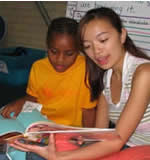The Harvard Family Research Project separated from the Harvard Graduate School of Education to become the Global Family Research Project as of January 1, 2017. It is no longer affiliated with Harvard University.
Teacher Commentary: Using Halmoni and the Picnic in the Classroom

As a third grade teacher in New York City, Elaine Hou piloted her guide for teachers for using Halmoni and the Picnicin her classroom.
The Lesson Plan
I reworked the guide to fit into the Reader's and Writer's Curriculum from Teacher's College, Columbia, that schools in New York City had adopted. Over a 5-day period and using the seven-step architecture of the reader's workshop, my students and I focused on the following objectives:
- Day 1: Readers pay close attention to a character's challenges when he or she comes from a culture different than their own.
- Day 2: Readers think about family relationships in a family that involves more than one culture.
- Day 3: Readers pay close attention to what a character from a culture different than their own contributes to his or her new surroundings.
- Day 4: Readers think about what each character in the story learns when different cultures interact (Halmoni, Yunmi, her school friends, and the teacher).
- Day 5: Readers think about how the school can be a place where family members from different cultures learn and give.
Similarly, other educators should regard the guiding themes and ideas presented in the teacher guide as general suggestions to be adapted to the lesson objectives and teaching formats appropriate to their own classrooms and school situations.
Introducing a New Word
I gathered my own third grade students to the rug to talk about the word culture. At the end of this introductory brainstorming, students came up with ideas such as “food,” “clothing,” “use of technology,” “traditions,” “shared beliefs,” “language,” and “feelings about oneself” to define culture. Students then talked with their reading partners about their own cultures—what they felt was important in their cultures, how they felt about being American and from another culture, and so forth. Then students shared the ideas from their conversations aloud. I also talked about myself as a Chinese American. From this session, the students and I came up with the question: What are the challenges a person faces when he or she lives in a new culture?
Reflections With the Family
As a homework extension to initial discussions in the classroom, I gave my students a writing assignment in which they were asked to think about someone in their own life who has had to get used to a new culture, like Halmoni. I asked them to describe the person's feelings and challenges and think about what could help this person get used to a new culture.
Family Recipes
As a follow-up to our discussions of Halmoni and the Picnic, students in my class contributed family recipes to an end-of-the-year class magazine. One student asked all of the women in her family, including her mother, aunt, and grandmother, to share one favorite recipe. She wrote about how all these recipes could now be passed down to her. The class also had a culminating class picnic at the end of the year, in which family members made special dishes and brought them to share with everyone.
Conclusion
Overall, I had a great time trying out these materials with my third graders—who represent Dominican, Mexican, Peruvian, and African American backgrounds. It was wonderful to see their thinking and discuss the story in depth with them. My students could all relate very closely to this story because they have grandparents who often feel lonely, stay at home most of the time, and are unsure about living in America. One of my students, who had behavior problems earlier in the year, brought his grandfather on a class trip and really tried to involve him in the exhibits. It was so great to see!
Reference
Choi, S. N. (1993). Halmoni and the picnic. Boston: Houghton Mifflin. In the story, a student worries that her classmates will make fun of her Korean grandmother, Halmoni, who has agreed to chaperone the class at a picnic in Central Park in New York City. With help from the teacher, students learn to address Halmoni according to Korean customs and to appreciate the unfamiliar food she brings to the picnic.
Developed by Elaine Hou, May 2004

